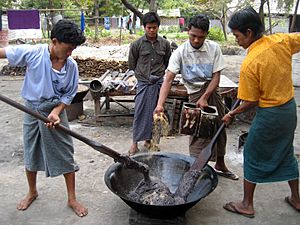Htamanè facts for kids

Htamanè with fritters and garnish
|
|
| Course | Seasonal festive dish |
|---|---|
| Place of origin | Myanmar |
| Created by | Mon people |
| Main ingredients | Glutinous rice, fried coconut shavings, roasted peanuts, toasted sesame, ground nut oil, ginger |
Htamanè (Burmese: ထမနဲ, pronounced: [tʰəmənɛ́]) is a special, tasty snack from Myanmar. It's made mostly from glutinous rice. People enjoy this sweet and savory treat during a special time of year.
This traditional food is usually prepared around the full moon day of Tabodwe. This month is the 11th month in the traditional Burmese calendar. It happens around February, just as the cool season is ending. Some famous places, like the Shwedagon Pagoda, even hold fun competitions to see who can make the best Htamanè!
Contents
How to Make Htamanè
Making Htamanè is a big job that often involves several people. It starts with carefully washing and soaking two types of glutinous rice. One is white, and the other is purple, called nga cheik.
Cooking the Rice Paste
Next, the soaked glutinous rice is put into a very large cooking pot. This pot sits on a low stove. Water and groundnut oil are added. The mixture is then kneaded, crushed, and boiled. It keeps cooking until it turns into a thick, dark gray paste.
Mixing the Dough
Once the rice paste is ready, the large pot is taken off the stove. It's placed on a small wooden block to keep it steady. This is when the main part of making Htamanè begins! Usually, three strong people work together for this step. Two people use huge wooden spatulas that look like rowing paddles. They mix the thick glutinous dough. A third person helps guide the spatulas, often holding them near the pot. This makes sure the mixing is done well.
Adding Flavorful Ingredients
Towards the end of the mixing, many tasty ingredients are added. These include toasted sesame seeds, roasted peanuts, and fried ginger. More groundnut oil and fried coconut shavings are also mixed in. All these ingredients get spread evenly throughout the dough. This gives Htamanè its unique and delicious flavor.
Serving Htamanè
After a batch of Htamanè is ready, more fried coconut shavings, peanuts, and sesame seeds are sprinkled on top. These are for garnish, making it look even more appealing. The taste of Htamanè is sweet and rich.
Sharing and Tradition
Htamanè is often made at monasteries or special shops. This is because it needs a lot of space and a large amount of ingredients. It's a big cooking project!
A Gift for Everyone
First, a small portion of the freshly made Htamanè is set aside. This is offered to the Buddha, which is a common custom. After that, the rest of the Htamanè is shared. People send it around their neighborhood. They also give it to family and friends as a special festival gift. It's a way to celebrate and share good wishes during this time of year.


